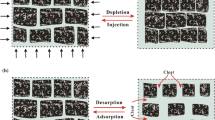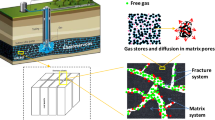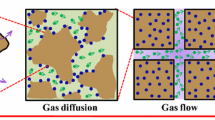Abstract
Coalbed methane (CBM) reservoirs show unique stress responses due to the additional sorption-induced effect under subsurface in situ condition. An insight of dynamic stress evolution is important to CBM development and carbon sequestration in coals. In this study, the combined controls of geomechanical effect and sorption-induced effect were gained to determine in situ stress evolution and predict mechanical failure in coals under uniaxial strain condition for various gases. We conduct a series of experimental measurements on stress path responses with continuous gas depletion for helium, N2, CH4 and CO2. The proposed model is validated by the experimental data, and then, we theoretically analyzed the stress evolution and potential mechanical failure behaviors for CBM operations. The applied horizontal stress was found to continuously decrease for all gas types with pressure depletion under uniaxial strain condition. Sorbing gas showed a higher excessive stress loss with the same decrement of gas pressure than that in non-sorbing gas depletion which is attributed to the sorption-induced effect. For helium depletion, horizontal stress variation is mainly controlled by geomechanical effect. Theoretically, coals with high gas affinity can induce relatively large horizontal stress loss. This excessive stress loss can trigger the localized instability of coal mass due to deviatoric stress trigger shear failure.














Similar content being viewed by others
References
Addis M (1997) The stress-depletion response of reservoirs. In: SPE annual technical conference and exhibition. San Antonio, Tex
Bieniawski ZT (1967) Mechanism of brittle fracture of rock: Part I—theory of the fracture process. Int J Rock Mech Min Sci 4:395–406
Biot MA (1941) General theory of three-dimensional consolidation. J Appl Phys 12(2):155–164
Chen D, Pan Z, Shi J, Si G, Ye Z, Zhang J (2016) A novel approach for modelling coal permeability during transition from elastic to post-failure state using a modified logistic growth function. Int J Coal Geol 163:132–139
Chen S, Tang D, Tao S et al (2018) Characteristics of in-situ stress distribution and its significance on the coalbed methane (CBM) development in Fanzhuang-Zhengzhuang Block, Southern Qinshui Basin, China. J Petrol Sci Eng 161:108–120
Clarkson CR (2013) Production data analysis of unconventional gas wells: review of theory and best practices. Int J Coal Geol 109–110:101–146
Clarkson CR, Pan Z, Palmer I, Harpalani S (2010) Predicting sorption-induced strain and permeability increase with depletion for coalbed-methane reservoirs. SPE J 15(1):152–159
Coussy O (2004) Poromechanics. Wiley
Cui X, Bustin RM, Chikatamarla L (2007) Adsorption-induced coal swelling and stress: implications for methane production and acid gas sequestration into coal seams. J Geophys Res Solid Earth 112:B10202
Espinoza DN, Vandamme M, Pereira JM, Dangla P, Vidal-Gilbert S (2014) Measurement and modeling of adsorptive-poromechanical properties of bituminous coal cores exposed to CO2: adsorption, swelling strains, swelling stresses and impact on fracture permeability. Int J Coal Geol 134–135:80–95
Espinoza DN, Pereira JM, Vandamme M, Dangla P, Vidal-Gilbert S (2015) Desorption-induced shear failure of coal bed seams during gas depletion. Int J Coal Geol 137:142–151
Fan L, Liu S (2018) Numerical prediction of in situ horizontal stress evolution in coalbed methane reservoirs by considering both poroelastic and sorption induced strain effects. Int J Rock Mech Min 104:156–164
Feng R, Harpalani S, Pandey R (2016) Laboratory measurement of stress-dependent coal permeability using pulse-decay technique and flow modeling with gas depletion. Fuel 177:76–86
Haimson BC, Cornet FH (2003) ISRM suggested methods for rock stress estimation—part 3: hydraulic fracturing (HF) and/or hydraulic testing of pre-existing fractures (HTPF). Int J Rock Mech Min 40(7–8):1011–1020
Haimson BC, Fairhurst C (1970) In-situ stress determination at great depth by means of hydraulic fracturing. In: Proceedings of the 11th US symposium on rock mechanics, Berkeley. SME/AIME, pp 559–584
Harpalani S, Chen G (1995) Estimation of changes in fracture porosity of coal with gas emission. Fuel 74(10):1491–1498
Harpalani S, Mitra A (2010) Impact of CO2 injection on flow behavior of coalbed methane reservoirs. Transp Porous Med 82:141–156
Harpalani S, Schraufnagel RA (1990) Shrinkage of coal matrix with release of gas and its impact on permeability of coal. Fuel 69(5):551–556
Hills R (2001) Coupled changes in pore pressure and stress in oil fields and sedimentary basins. Petrol Geosci 4(7):419–425
Hoek E, Brown E (1980) Underground excavations in rock. Inst. Min. 537 Metall, London
Hou X, Zhu Y, Fu C, Liu J (2016) Fractures distribution of Qinshui Basin and its indicative significance to unconventional gas co-exploration in coal measures. J China Univ Min Technol 45(4):729–738
Hou X, Zhu Y, Chen S, Wang Y (2017) Gas flow mechanisms under the effects of pore structures and permeability characteristics in source rocks of coal measures in Qinshui Basin, China. Energy Explor Exploit 35(3):338–355
Hou X, Zhu Y, Wang Y, Liu Y (2019) Experimental study of the interplay between pore system and permeability using pore compressibility for high rank coal reservoirs. Fuel 254:115712
Hou X, Liu S, Zhu Y, Yang Y (2020a) Evaluation of gas contents for a multi-seam deep coalbed methane reservoir and their geological controls: in situ direct method versus indirect method. Fuel 265:116917
Hou X, Liu S, Zhu Y, Yang Y (2020b) Experimental and theoretical investigation on sorption kinetics and hysteresis of nitrogen, methane, and carbon dioxide in coals. Fuel 268:117349
Izadi G, Wang S, Elsworth D, Liu J, Wu Y, Pone D (2011) Permeability evolution of fluid-infiltrated coal containing discrete fractures. Int J Coal Geol 85(2):202–211
Jaeger JC, Cook NGW, Zimmerman R (2007) Fundamentals of rock mechanics, 4th edn. Wiley-Blackwell
Johnson RC, Flores RM (1998) Developmental geology of coalbed methane from shallow to deep in rocky mountain basins and in cook inlet-Matanuska Basin, Alaska, U.S.A. and Canada. Int J Coal Geol 35:241–282
Kang H, Zhang X, Si L, Wu Y, Gao F (2010) In-situ stress measurements and stress distribution characteristics in underground coal mines in China. Eng Geol 116(3–4):333–345
Liu S, Harpalani S (2013) A new theoretical approach to model sorption-induced coal shrinkage or swelling. AAPG Bull 97(7):1033–1049
Liu S, Harpalani S (2014a) Compressibility of sorptive porous media: part 1. Background and theory. AAPG Bull 98(9):1761–1772
Liu S, Harpalani S (2014b) Compressibility of sorptive porous media: part 2. Experimental study on coal. AAPG Bull 98(9):1773–1788
Liu S, Harpalani S (2014c) Determination of the effective stress law for deformation in coalbed methane reservoirs. Rock Mech Rock Eng 47(5):1809–1820
Liu S, Harpalani S (2014d) Evaluation of in situ stress changes with gas depletion of coalbed methane reservoirs. J Geophys Res Solid Earth 119(8):6263–6276
Liu H, Rutqvist J (2010) A new coal-permeability model: internal swelling stress and fracture-matrix interaction. Transp Porous Med 82(1):157–171
Liu J, Chen Z, Elsworth D, Miao X, Mao X (2010) Linking gas-sorption induced changes in coal permeability to directional strains through a modulus reduction ratio. Int J Coal Geol 83(1):21–30
Liu J, Chen Z, Elsworth D, Miao X, Mao X (2011a) Evolution of coal permeability from stress-controlled to displacement-controlled swelling conditions. Fuel 90(10):2987–2997
Liu J, Wang J, Chen Z, Wang S, Elsworth D, Jiang Y (2011b) Impact of transition from local swelling to macro swelling on the evolution of coal permeability. Int J Coal Geol 88:31–40
Liu S, Harpalani S, Pillalamarry M (2012) Laboratory measurement and modeling of coal permeability with continued methane production: part 2—modeling results. Fuel 94:117–124
Liu A, Liu S, Wang G, Elsworth D (2020a) Continuous compaction and permeability evolution in longwall gob materials. Rock Mech Rock Eng. https://doi.org/10.1007/s00603-020-02222-z
Liu A, Liu S, Wang G, Sang G (2020b) Modeling of coal matrix apparent strains for sorbing gases using a transversely isotropic approach. Rock Mech Rock Eng 53(9):4163–4181
Liu A, Liu S, Harpalani S (2021) The role of sorption-induced coal matrix shrinkage on permeability and stress evolutions under replicated in situ condition for CBM reservoirs. Fuel 294:120530
Lu M, Connell L (2016) Coal failure during primary and enhanced coalbed methane production—theory and approximate analyses. Int J Coal Geol 154–155:275–285
Luo C, Zhang D, Lun Z et al (2019) Displacement behaviors of adsorbed coalbed methane on coals by injection of SO2/CO2 binary mixture. Fuel 247:356–367
Ma X, Zoback MD (2017) Laboratory experiments simulating poroelastic stress changes associated with depletion and injection in low-porosity sedimentary rocks. J Geophys Res Solid Earth 122(4):2478–2503
Ma Q, Harpalani S, Liu S (2011) A simplified permeability model for coalbed methane reservoirs based on matchstick strain and constant volume theory. Int J Coal Geol 85(1):43–48
Masoudian MS, El-Zein A, Airey DW (2016) Modelling stress and strain in coal seams during CO2 injection incorporating the rock-fluid interactions. Comput Geotech 76:51–60
Masoudian MS, Hashemi MA, Tasalloti A, Marshall AM (2018) Elastic-brittle-plastic behaviour of shale reservoirs and its implications on fracture permeability variation: an analytical approach. Rock Mech Rock Eng 51(5):1565–1582
Masoudian MS, Leonardi C, Chen Z, Underschultz J (2019) The effect of sorption-induced shrinkage on the ground surface movement above gas-producing coalbeds. In: 53rd US rock mechanics/geomechanics symposium. American Rock Mechanics Association
Meng Z, Zhang J, Wang R (2011) In-situ stress, pore pressure and stress-dependent permeability in the Southern Qinshui Basin. Int J Rock Mech Min 48(1):122–131
Mitra A, Harpalani S, Liu S (2012) Laboratory measurement and modeling of coal permeability with continued methane production: part 1—laboratory results. Fuel 94:110–116
Moore TA (2012) Coalbed methane: a review. Int J Coal Geol 101:36–81
Moore RL, Loftin D, Palmer I (2011) History matching and permeability increases of mature coalbed methane wells in San Juan Basin. In: SPE Asia Pacific Oil and Gas Conference and Exhibition, Jakarta, Indonesia
Mukherjee M, Misra S (2018) A review of experimental research on enhanced coal bed methane (ECBM) recovery via CO2 sequestration. Earth Sci Rev 179:392–410
Nur A, Byerlee JD (1971) An exact effective stress law for elastic deformation of rock with fluids. J Geophys Res 76(26):6414–6419
Okotie VU, Moore RL (2010) Well-production challenges and solutions in a mature, very-low-pressure coalbed-methane reservoir. In: SPE annual technical conference and exhibition, Florence, Italy
Palmer ID, Moschovidis ZA, Cameron JR (2005) Coal failure and consequences for coalbed methane wells. In: SPE annual technical conference and exhibition, Society of Petroleum Engineers, Dallas
Pan Z, Connell LD (2007) A theoretical model for gas adsorption-induced coal swelling. Int J Coal Geol 69(4):243–252
Pan Z, Connell LD (2012) Modelling permeability for coal reservoirs: a review of analytical models and testing data. Int J Coal Geol 92:1–44
Sang G, Elsworth D, Liu S, Harpalani S (2017) Characterization of swelling modulus and effective stress coefficient accommodating sorption-induced swelling in coal. Energy Fuel 31(9):8843–8851
Saurabh S, Harpalani S (2018) Stress path with depletion in coalbed methane reservoirs and stress based permeability modeling. Int J Coal Geol 185:12–22
Saurabh S, Harpalani S, Singh VK (2016) Implications of stress re-distribution and rock failure with continued gas depletion in coalbed methane reservoirs. Int J Coal Geol 162:183–192
Seidle J, Jeansonne M, Erickson D (1992) Application of matchstick geometry to stress dependent permeability in coals. In: SPE rock mountain regional meeting, Casper, Wyoming
Shi J, Durucan S (2004) Drawdown induced changes in permeability of coalbeds: a new interpretation of the reservoir response to primary recovery. Transp Porous Med 56(1):1–16
Shi J, Durucan S (2018) Variation in horizontal stress with pore pressure depletion in coal under uniaxial strain conditions: an update on the modelling of laboratory data. Int J Coal Geol 187:94–97
Shi J, Durucan S, Shimada S (2014) How gas adsorption and swelling affects permeability of coal: a new modelling approach for analysing laboratory test data. Int J Coal Geol 128–129:134–142
Sreenivasulu B, Sreedhar I, Suresh P, Raghavan KV (2015) Development trends in porous adsorbents for carbon capture. Environ Sci Technol 49(21):12641–12661
Terzaghi K (1925) Principles of soil mechanics, IV-settlement and consolidation of clay. Eng News Rec 95(3):874–878
Wang K, Zang J, Wang G, Zhou A (2014) Anisotropic permeability evolution of coal with effective stress variation and gas sorption: model development and analysis. Int J Coal Geol 130:53–65
Wang Y, Liu S, Zhao Y (2018) Modeling of permeability for ultra-tight coal and shale matrix: a multi-mechanistic flow approach. Fuel 232:60–70
Wei C, Zou M, Sun Y, Cai Z, Qi Y (2015) Experimental and applied analyses of particle migration in fractures of coalbed methane reservoirs. J Nat Gas Sci Eng 23:399–406
White CM, Smith DH, Jones KL et al (2005) Sequestration of carbon dioxide in coal with enhanced coalbed methane recovery a review. Energy Fuel 19(3):659–724
Yang Y, Liu S, Zhao W, Wang L (2019) Intrinsic relationship between Langmuir sorption volume and pressure for coal: experimental and thermodynamic modeling study. Fuel 241:105–117
Zhang R, Liu S (2017) Experimental and theoretical characterization of methane and CO2 sorption hysteresis in coals based on Langmuir desorption. Int J Coal Geol 171:49–60
Zhang Q, Fan X, Liang Y et al (2017) Mechanical behavior and permeability evolution of reconstituted coal samples under various unloading confining pressures—implications for wellbore stability analysis. Energies 10:292
Zoback (2008) Reservoir geomechanics. Cambridge University Press, New York
Acknowledgements
This study was sponsored by State Kay Laboratory of Coal and CBM Co-mining (Grant#2018kf05) and National Science and Technology Major Project (2016ZX05067) of Shanxi.
Author information
Authors and Affiliations
Corresponding author
Additional information
Publisher's Note
Springer Nature remains neutral with regard to jurisdictional claims in published maps and institutional affiliations.
Rights and permissions
About this article
Cite this article
Hou, X., Liu, S., Li, G. et al. Quantifying and Modeling of In Situ Stress Evolutions of Coal Reservoirs for Helium, Methane, Nitrogen and CO2 Depletions. Rock Mech Rock Eng 54, 3701–3719 (2021). https://doi.org/10.1007/s00603-021-02511-1
Received:
Accepted:
Published:
Issue Date:
DOI: https://doi.org/10.1007/s00603-021-02511-1




